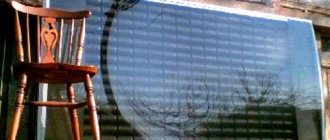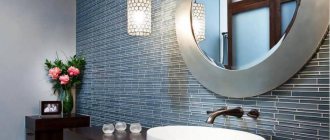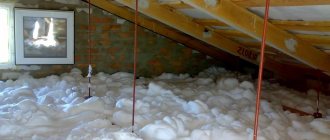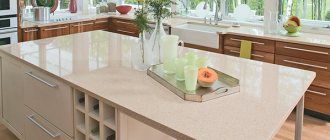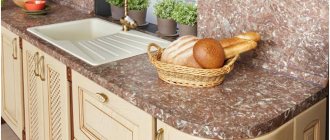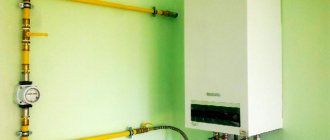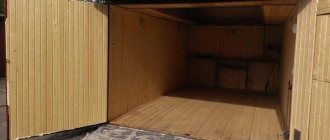Larch table
You can purchase laminated boards, solid-lamella or spliced, in Moscow through the company Dilect, which is a manufacturer and supplier. Production according to sizes provides a range of lengths from 0.9 to 5.0 m, widths from 20 cm to 1 m 20 cm. A tabletop made of solid larch based on a furniture panel will be made quickly with ideal quality!
Table tops made of solid larch
The Dilect company produces custom-made larch tabletops using furniture panels as a base: solid-lamella or jointed. Finished surfaces are made strictly to size, taking into account the required thickness (standard - 20 or 40 mm).
Glued blanks are used to make beech or oak tabletops to order. Sawing of a round or rectangular surface is carried out using modern equipment strictly according to the dimensions provided by the customer. Furniture panels are produced by deep processing of solid wood, sawing into lamellas of the same thickness and width, followed by gluing under a press. The resulting glued blank is characterized by high strength and durability. For further furniture production, it is recommended to use Extra or A/A grade boards.
All-lamella larch countertops for the kitchen are characterized by the beauty of their texture and maximum resemblance to natural solids. Spliced panels are used in furniture production for the manufacture of the following elements:
- cabinets;
- beds;
- stairs;
- tables, window sills, shelves.
Round surfaces made of ash wood, 20/40 mm thick, are beautiful and practical.
Accommodation
Country and garden furniture made of solid larch does not require special care methods; it does not require covering or impregnation. Place the model in any corner of the garden plot. Depending on the type and purpose, you can create stationary areas or mobile rest areas using folding items.
Products made from larch lamellas for the home are massive and take up a lot of space. When choosing a model, it is necessary to take into account the area of the room, dimensions, and possible load of the item. A table or work surface should be installed in a spacious kitchen or dining room. If a type of dark tones was used in the production of a cabinet or kitchen set, in order to visually expand the space, you need to place accents, leaving the walls and floors lighter. When purchasing pieces of furniture for a children's room, you need to pay attention to its surface, the method of processing, and sanding in order to protect the child from splinters.
Furniture should not be exposed to direct sunlight, especially if it has decorative elements: fabric, leather, metal. The effect of heating elements also deteriorates the quality of products, promoting moisture loss, discoloration, and cracking. Therefore, placing furniture close to a radiator or heater is prohibited. In winter, when the indoor air is dry, it is recommended to ventilate the room more often or install additional humidification options: an aquarium, a fountain, a humidifier.
Thanks to its characteristics, larch has occupied a special niche in furniture production. In addition to high performance qualities, naturalness, and environmental friendliness, consumers appreciated the aesthetic properties of the breed, a rich range of colors, natural shine, and unique patterns. Products made from larch create comfort and warmth in the room, filling the air with useful substances, making the interior noble and unique. It is necessary to choose furniture taking into account its features, room size, and style.
Advantages and disadvantages
Furniture made from larch attracts the eye with its beauty, unusualness, it has properties that allow the product to be used in several directions. Being a valuable coniferous material, the species is successfully used in the construction of baths, houses, saunas, exterior decoration of premises, and verandas. But real connoisseurs and experts in the field of larch use advise purchasing interior items and furniture sets of this species.
Furniture items made from larch have constant advantages that distinguish them favorably from other types of furniture industry.
Advantageous product characteristics:
- high density of wood, which only increases over time;
- furniture resistance to deformation, high strength;
- naturalness, environmental friendliness;
- gum, which is part of the wood, protects products from mold, rotting, and the appearance of fungi;
- furniture resistance to temperature changes, changes in humidity, wood absorbs moisture well;
- resistance to loads, mechanical shocks;
- fire resistance of furniture;
- Having the strength of oak, larch is much cheaper;
- attractive appearance, variety of colors and patterns depending on the region of growth.
Larch furniture reflects the originality of taste and style of the owner. Being the embodiment of elegance and luxury, such a product will last for many years without requiring careful maintenance or restoration. Thanks to the resin content, objects emit a slight pine scent, which allows you to create a special microclimate in the room, helping you relax, calm down, and receive an aromatherapy session.
Despite the numerous advantages of the breed, there are some disadvantages that have their effect:
- complexity of processing, which affects the production time and cost of products;
- uneven drying;
- bulkiness, massiveness of products when using gluing technology.
Pros and cons of wooden surfaces
Have you not yet fully decided whether to opt for a wooden tabletop, or is it better to turn to other materials? Especially for this case, we have prepared a brief overview of the pros and cons of wooden options.
Main advantages:
- environmental friendliness;
- stylish and current appearance that does not go out of fashion;
- warm surface;
- cozy texture;
- the ability to fit into any interior style;
- durability (with proper care).
Key disadvantages of wooden countertops:
- quite easy to scratch;
- flammable material;
- high price;
- require regular careful surface care;
- do not accept aggressive household chemicals and abrasive detergents.
Strength
In terms of strength, larch surpasses such wood species as pine, spruce, birch, beech, ash and even oak. Therefore, you can safely use it as a material for a countertop. Despite the fact that such a surface is designed for constant mechanical loads, larch will last as long as possible, maintaining the attractiveness of a natural wood product.
In addition, this species has higher viscosity values compared to other conifers. This characteristic is also important when choosing wood for a countertop.
Moisture resistance
Immunity to high humidity is a factor without which it is impossible to imagine choosing a countertop. After all, this product is used in rooms with the highest level of humidity in a house or apartment. Larch wood copes well with moisture - it does not deform and does not lose its original appearance. After processing, it is often used as a construction or finishing material for the facades of buildings and street structures. And larch can handle water in the kitchen or bathroom without difficulty. And will retain its performance characteristics for many years.
Decorativeness
Larch wood has an interesting pattern of contrasting fibers, and the dark knots found on its surface look very expressive. The required shade is achieved through additional treatment with varnishes. Such a countertop will certainly become the highlight of the interior and a real decoration of the kitchen or bathroom, because classic solutions using natural wood will never go out of fashion!
We recommend: How to close vents in the foundation for the winter
Environmental friendliness
In terms of environmental friendliness, wooden products are far behind products made from MDF and chipboard, which contain binding resins that emit a substance harmful to humans - formaldehyde. In the production of countertops, Larix uses only natural ingredients and environmentally friendly substances. Countertops made of natural stone demonstrate a similar degree of safety, but their cost is much higher than models made of larch.
Nuances of processing structures
The characteristic features of the breed, which are highly valued in furniture production, make it difficult and labor-intensive to process the material. Given its hardness and high resin content, manufacturers use special technologies aimed at preventing cracking and oiling of cutting equipment.
Raw materials go through several stages of production:
- harvesting - selection, marking of trees, cutting;
- mechanical processing - includes cleaning trunks from branches, bark, sawing into boards;
- atmospheric, chamber drying;
- cutting, grinding on a machine;
- gluing, finishing.
Processing the material has its own nuances:
- quick drying is not applicable;
- The wood is easy to paint and can be tinted after preliminary de-resining.
A shield made in this way is not subject to deformation; there are no visible defects, cracks, stains, or knots on its surface. Boards for the production of furnishings are panels made of timber or continuous lamellas glued into strips.
The lamellas are made from solid wood, which is more resistant to bending and durable. It is preferable to choose such lumber for work surfaces, countertops, and bookshelves.
An indicator of quality during production is the radial cut, which is visible on the left side of the lamella.
Gluing the material can have several options:
- single layer;
- two-sided;
- spliced along the length of the fiber;
- cladding with valuable species.
When choosing a glued board, you need to take into account the purpose of the product: strength, reliability of the structure, or an effective decor that complements the interior. Furniture made from larch does not require additional processing. However, you need to remember that wood products must be in harmony with the interior style and overall color scheme. If the natural color of the products does not match the decor, it can be changed using stain, paint, varnish, but only in a darker direction. When making furniture, you can achieve the effect of artificial aging using chemical, mechanical, and thermal methods.
Features of a wooden table top
Wood is an excellent material from which furniture is made. Inexperienced and little-informed people in this matter worry about the possibility of fungus, mold, and cracked varnish. Professionals think differently. In their opinion, a wooden countertop is no worse than its analogues made of artificial stone, for example.
Wooden countertops are not inferior in quality to furniture made from other materials.
Using the necessary and proper care, the tree will please the eye for a very long time. There are practically no materials used in the kitchen that are weakly subject to wear and tear. The peculiarity of wood is that it can age gracefully. In order to save money, you can make only the surface of the working area from a natural component, which will combine well with individual decorative elements.
Alternatively, only the surface of the working area can be made of wood.
Manufacturing of carpentry panels
We select dry boards of the same thickness
Making a carpentry panel is the arrangement of pre-prepared elements. The main parts of the carpentry panel are wooden boards. But first they need to be specially processed.
Cut the boards to the required size
We process the surfaces of all boards using a plane and jointer
Use a plane to level the surface of the board material. Using sandpaper, carefully sand the surface. After grinding, the prepared material must be treated with an antiseptic.
Sand with sandpaper or a sander
Construction stores have a huge selection of them, but please note that you need a solution for interior work. The antiseptic will protect the wood from excess moisture, which is available in abundance in the kitchen, and will prevent the appearance of mold and insects.
There are several ways to connect parts together.
Factors of wood damage
If the room has high humidity, poor ventilation and a comfortable temperature for the growth of bacteria (depending on the type - from 15 to 65 ° C) and moldy fungi, any wooden surface is at risk.
This is how a kitchen cutting board can turn black.
Do not forget - and this applies mainly to the kitchen - that aggressive solutions (acids and alkalis) change the chemical composition of wood and thereby worsen its appearance and strength characteristics.
Another factor of damage is direct sunlight. But here the situation is ambiguous: on the one hand, ultraviolet light has a pronounced bactericidal effect. But in addition to destroying bacteria, it almost instantly begins to destroy the unprotected surface of the tree. It becomes silver-gray in color and loses strength.
Finally, do not forget about possible (and in the case of a cutting board, inevitable) mechanical damage. They put a hot frying pan on, scratched it with a knife - they ruined the tabletop or board.
It may seem subjective, but we are for butter. Yes, the varnish coating looks beautiful, dries quickly and is inexpensive.
But the varnish coating has disadvantages, which in the case of countertops and especially cutting boards will emphasize the advantages of oil:
- The varnish is not recommended for use in rooms with high humidity.
- The varnish can hardly withstand temperature changes: and this happens often in the kitchen.
- The varnish coating is easily damaged even with slight impact - a scratch on oiled wood is much less noticeable.
- Damaged varnish cannot be restored in a separate area - you will have to completely remove the coating and apply a new one.
Any defects on the varnish become immediately visible.
How to protect a wooden table
The varnish coating adorns the wood. With it, the wood texture appears more clearly, the color becomes more saturated, and a specific gloss appears. The most important thing is that the coating protects the wood, and with it the service life of the wooden panel increases to 10 years.
Varnish coating decorates the wood
There are many factors in the kitchen that negatively affect wood: water, hot objects, sharp objects. High humidity and processes associated with cooking provoke the appearance of fungus on wood. The varnish coating protects from all this.
There are many factors in the kitchen that negatively affect wood: water, hot objects, sharp objects.
This type of wood processing is a very complex and labor-intensive process that consists of several stages. How to varnish a tabletop is an art. Since after the composition has hardened, nothing can be changed without a complete rework, the preparatory stages are carried out very carefully.
How to varnish a tabletop is an art.
The surface is completely cleaned, sanded and treated with a special chemical remover. After this, it is wiped with alcohol or acetone, which completely removes traces of fat. Then the composition is applied in three layers, each layer being given time to dry and harden.
The surface is completely cleaned, sanded and treated with a special chemical remover.
Important! The quality of the pre-treatment determines the protection of the wood under the varnish coating and the durability of the latter. Remaining grease or moisture can cause defects or rot in the wood.
How to restore a wooden table
Before you varnish your dining table or kitchen worktop, you should evaluate the condition very carefully.
The surface may already be painted, mechanically processed, glossy, or varnished. Regardless of what varnish the surface will be coated with, it is necessary to carry out preparatory work. In the video: how to cover a table with stain.
Preparation
The first step is to remove all the old coating. This is done so that the texture of the wood is clearly visible, using an electric tool. When the table is as smooth as possible, the surface does not have any defects, then you can move on to the next stage.
Removing old coating
The chemical remover is applied to the table surface and then wiped off after 10 minutes. To apply and remove a layer of paint or varnish, use a rag.
You can also remove the old coating by sanding. Doing this by hand takes a very long time, so it is better to use a power tool. The work is performed at low speeds so as not to damage the wood.
Varnish application technology
To apply varnish, it is better to use brushes or rollers. Using a colorless varnish for a wooden table in one layer, it is very difficult to obtain the desired shade - this is only possible if you cover the surface in several layers.
After the stains and primers have dried, they can be varnished. The varnish is applied in a thin, even layer, trying to avoid drips. After the first layer has dried, it is recommended to sand the surface. For a high-quality result, varnish in three layers of varnish.
In a day, the old table will turn into a new one and no one will ever be able to say that it is very old. Knowing how to cover a table, you can restore other wooden furniture in this way.
How to cover the tabletop
Having decided on the material, you need to understand that the optimal surface for the table will only be natural wood. In no case is veneer, MDF or chipboard used. Particular attention is paid to the age of the tree, its place of growth, and storage conditions.
Natural wood is the best option for making countertops.
It is important to know that a laminated wood surface will be more elastic and flexible than the same surface made from solid wood. The type of raw material is also important. Care methods must necessarily include treatment with special protective agents. What is the table covered with? It can be varnish, wax or oil.
There are three options for covering the table surface: varnish, wax and oil.
We recommend: Priming walls for painting: everything about choosing the material and applying it correctly.
Practicality or durability
In order not to make a mistake in your choice, you should keep in mind some features of tree species. Harder ones, such as oak or beech, will last longer. However, their cost is much higher.
Hardwood furniture will last longer.
Among the democratic ones, pine, birch, ash or larch are perfect. Speaking about the latter, we should note a number of advantages. Its surface is quite dense and resistant to various types of damage. The presence of gum in the composition prevents the growth of fungi and mold, as well as rot, which is very important considering where it will be used. Larch is also capable of absorbing or releasing excess moisture.
Larch is also optimal for countertop material.
Oil, wax or varnish
Avoiding the harmful effects of water, temperature, acid and alkali will help extend the life of a wooden tabletop. Here the question immediately arises of how to cover a wooden tabletop so that it lasts a long time.
Among those available, processing using the following means is suitable:
- oil;
- wax;
- varnish
Surface treatment with oil, or rather its impregnation, is the optimal way to protect wooden products. It provides a kind of barrier that repels water from the surface. Oil absorbed into the top layer of wood will prevent it from getting wet when in contact with water. Oil compositions are not washed off, but require frequent use. At the moment, you can choose different compositions that match the color.
Oil protects wood from moisture.
Wax is a natural and environmentally friendly material. The effect of its use is similar to oil. But in addition to protecting against water, the wax coating also protects against minor mechanical impacts (scuffs and scratches). However, there are also disadvantages. A wax coating wears out quickly and requires updating and polishing more often than an oil coating. Before this, the old layer is cleaned off.
The wax coating requires regular updating.
Using varnish on a wooden tabletop is a radical method. It protects wood from water, minor mechanical damage, and exposure to ultraviolet radiation, while the structure of the tree itself does not change. The color of the surface remains the same, and a natural exchange of moisture also occurs, preventing the appearance of fungi and mold.
The varnish protects the surface from all contamination.
This coating also protects against temperature influences without flaking or cracking. To remove the varnish coating, the tabletop will have to be scraped.
Preparing the surface for painting
The countertop that you plan to paint must be clean, intact and dry. Fill all chips and cracks with putty, after drying, clean these places, or better yet, the entire surface as a whole. This will not only get rid of differences and unevenness, but also give the surface roughness, which will improve paint adhesion.
If the tabletop is very old, with multiple damages, and you doubt that you will be able to repair them perfectly, it is better to make an overlay - for example, from an MDF sheet or moisture-resistant plywood. By screwing such an overlay to the surface, you will get a smooth surface ready for painting. Only the edges need to be sealed with putty.
To improve paint adhesion, use a primer that matches the material of the countertop (primer for wood, primer for mineral surfaces, etc.). Or use a universal primer. Allow the primed countertop to dry before you begin painting. Not only the top layer, but the entire countertop as a whole should be dry. Some materials (wood, unglazed ceramics) absorb the primer especially actively, so it is better to continue the work the next day.
Coating process
Proper treatment of a wooden surface is the key to its long service life. This rule especially applies to kitchen countertops. In addition to the fact that you need to choose the right treatment product, it is also important to properly prepare the surface, apply protection and dry. The following describes the process of how to coat surfaces using oil compositions as an example.
The coating process follows certain rules.
Preparation of the product
The main thing you need to pay attention to when choosing a coating is its quality. A good protective agent will protect the wooden surface from mechanical damage and moisture and give it a shiny, renewed look.
The coating must be of high quality to provide the furniture with protection and a well-groomed appearance.
The product must also be prepared. Before treating a wooden countertop in the kitchen, the composition must be thoroughly mixed for 5 minutes.
The product must be mixed well.
Preparing the wooden surface
The first step will be to clean the countertop from all kinds of dirt and greasy marks. Next it is dried.
Before coating, the surface must be cleaned of dirt.
On a note! The wood moisture content should be no more than 12% according to DIN EN 13183-2.
To ensure that the oil adheres well and is absorbed, the wood is sanded, starting with coarser abrasives, gradually moving to finer ones. Also, after each abrasive, the coating is cleaned. You may need to putty it to remove deeper scratches. A special restoration kit based on wax is ideal.
The wood should be sanded so that the coating lays more evenly.
Application
The composition is applied with a brush or cloth, and the latter should not leave lint on the surface. It will take about 12 hours for the first layer to dry. Then you can apply the next one, and so on. The number of layers will directly depend on how the product is applied. Using a brush, two treatments are enough; a fabric coating will require up to 4 layers.
Use a brush or cloth for application.
When the product is well absorbed, the entire treated area is thoroughly wiped with a soft and clean cloth.
After the product has been absorbed, wipe the surface with a cloth.
Drying
Drying time varies from several hours to several days. Naturally based oils or mixtures containing acrylic require a longer drying period. They can also increase strength gradually. It is important not to use a freshly treated countertop for a while.
After applying the coating, it is important to let the furniture dry.
Ways to protect your kitchen work surface
The work area of the room in which food is prepared is exposed to a variety of liquids, so in order for it to serve for a long time, it must be protected from water.
There are several options for this:
- Use oil to treat objects made of wood, which is absorbed into the material and prevents the fibers from swelling when wet. The following industrial products can be used for the wood surface: OSMO TopOil, Belinka, Adler Legno or others. To treat the area to be worked simultaneously with this substance or even instead of it, use specialized wax. But we must not forget that this product will have to be renewed over a certain period of time, in other words, applied again.
- Treat it a couple of times with a special varnish for wooden surfaces. If desired, a little pigment is added to it so that the deep wood fibers become darker, and the surface itself for cooking becomes more expressive.
Oil based coating for kitchen fittings
Oil protects furniture from exposure not only to moisture, but also from chemical, natural and household influences. This factory-made product is largely colorless and may be plant-based, mineral-based, or artificial.
Similar coatings differ from each other in the way they set:
- It dries completely, hardens after drying, it is not possible to wash it off with water and the initial appearance of the finished furniture is preserved for a very long time.
- Absolutely non-drying or half drying, it saturates the wood very deeply. It is made using natural elements. It is removed using the influence of mechanics.
Before applying such a product, the surface to be treated is thoroughly cleaned of all contamination and dried. If there is a need for paint that is already outdated or the varnish will have to be removed. And if there are flaws, then they need to be smoothed out with a specialized putty, and then polished with sanding tape.
The oil is applied using a brush or cloth that does not leave lint, it is applied along the entire length of the fibers. The very first layer should dry for twelve hours, after which a new layer is applied. The total number of them in a given composition depends on the method in which we apply the product itself. If a brush is used, two treatments will be done. And when using a rag, you need to do three or 4 layers. After complete absorption of the composition, the entire treated area should be thoroughly wiped with a soft and clean cloth.
The provided coverage has a number of positive parameters:
- Does not change the color of the surface for working with food, its “pattern” stands out.
- It leaves the first real exchange of moisture in the surface and prevents the formation of fungi, thanks to which the initial appearance of the finished area does not change for a long time.
- If very high temperatures are applied to the outer part of the object for such finishing, then the product does not delaminate and does not leak.
- Furniture oil is considered environmentally friendly, thanks to which the contact of food components with the surface on which the described composition is present will not harm human health.
- Oil hides small scratches, worn areas and stains left by cookware.
- If there is a need to refresh contaminated areas, then you can remove only part of this coating, and then apply it again to the necessary areas.
- The oil is perfect even for aged wood containing pores, since it is deeply absorbed, gives it plasticity and prevents it from drying out.
Main advantages of varnish
Due to the wide variety of varnish coatings, this method of protecting wood is the most popular compared to oil impregnation. Despite some of the disadvantages mentioned above, this method has many positive aspects:
- Strength and durability, does not require restoration during its service life
- Possibility to choose the desired shade and adjust the color of the wood
- Protects wood from fire and combustion
- Protects wood from moisture
- Gives a perfectly smooth surface
Types of oils by drying
Oil dries more slowly than varnish because it penetrates into the wood and the varnish polymerizes on its surface. But oils are different: depending on the composition, there are completely drying and non-drying ones.
We recommend: How to attach a baseboard to a countertop
For initial impregnation of wood, a linseed oil coating is most often used. Adding tung oil to it speeds up the drying process. In this case, tung oil perfectly replaces metal driers (a substance that is added to the oil to speed up drying).
G-Nature natural countertop oil uses this exact combination. It also contains rosin as an excellent antiseptic and wax to give the surface a matte shine after polishing.
Alternative options
A good alternative to varnish for a kitchen countertop is to impregnate the wood with vegetable oils. Typically, mixtures of tung, linseed, and citrus oils are used.
A good alternative to varnish for a kitchen countertop is to impregnate the wood with vegetable oils.
The main advantages of oil impregnation compared to varnishing:
Environmentally friendly. Oils do not contain harmful substances that are necessary for film formation.
Oils do not contain harmful substances that are necessary for film formation.
Ease of use. Small scratches here are practically not noticeable and do not spoil the appearance. In case of serious damage to the surface, the damaged part can be sanded and then coated with oil again. Moreover, you can do this yourself. When restoring a varnish coating, it is necessary to treat the entire surface completely.
Small scratches here are practically not noticeable and do not spoil the appearance. In case of serious damage to the surface, the damaged part can be sanded and then re-coated with oil.
Oil impregnation does not change color and does not look noticeable, preserving the natural appearance of the wood. Oils can dry completely or partially. In the first case, they form a durable film; in the second, they can be erased from the surface of the wood over time.
Oil impregnation does not change color and does not look noticeable, maintaining the natural appearance of the wood.
Tabletop care
Unlike other types of surfaces, wood requires constant care and attention to use. Varnish coating is not a panacea for damage and scratches. First of all, it prevents moisture, grease, and salt from entering and absorbing into the wood, thereby corroding it.
Unlike other types of surfaces, wood requires constant care and attention to use.
It is also important to protect the varnish coating itself from damage: do not place it hot on the countertop, do not allow moisture or grease to remain on it for a long time. Otherwise it will cause white spots to appear. If, however, the table was damaged, the covering will have to be completely restored. To do this, the object is completely sanded, removing the thinnest top layer and coated with a new layer of varnish.
It is also important to protect the varnish coating itself from damage: do not place it hot on the countertop, do not allow moisture or grease to remain on it for a long time.
Care instructions
In order for a wooden tabletop to retain its appearance longer, it is necessary to properly care for it:
- The wood is wiped with mineral oil. It adds shine and prevents the growth of harmful microbes.
- Every day, remove any remaining water and food, first with a damp sponge, then wipe dry. To clean the countertop and wash dishes, use different sponges and rags.
- Hot dishes, iron containers with sharp edges at the bottom, heavy kitchen appliances are placed on stands.
